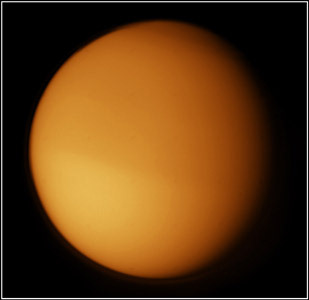Hot-air balloon will shed more light on Saturn’s moon Titan
 Washington, Nov 7 : Scientists are envisioning sending a hot-air balloon to explore Titan in the future, which would divulge much more details about Saturn’s largest moon than revealed by earlier space missions.
Washington, Nov 7 : Scientists are envisioning sending a hot-air balloon to explore Titan in the future, which would divulge much more details about Saturn’s largest moon than revealed by earlier space missions.
The plan to send a hot-air balloon to Titan, as well as an orbiting spacecraft and a surface probe, is being drafted by Athena Coustenis, an astrophysicist and planetologist with the Paris Observatory.
Called TSSM (Titan and Saturn System Mission), this three-tiered approach to exploration could shed more light on the still-mysterious moon.
“Titan is the best place to go with a balloon because of the atmosphere,” said Coustenis.
Although the atmosphere of Titan is filled with a smoggy orange hydrocarbon haze, it is primarily composed of nitrogen — just like Earth’s.
In fact, astrobiologists think Titan’s atmosphere may be quite similar to how the Earth’s was billions of years ago, before life on our planet generated oxygen.
To move around, the TSSM ground probe could be outfitted with a helicopter rotor that would allow it to fly from place to place.
The probe design also may include floaters that would prevent it from sinking if it landed on one of Titan’s hydrocarbon lakes.
The probe also would have a scoop to help it analyze the surface soil or liquid.
The models for Titan suggest the surface would be primarily made of hydrocarbon particles that rained out of the thick atmosphere, but according to Coustenis, they are still unsure of exactly what the chemistry of Titan’s surface is like.
“If you ask me what the dunes are made of, I don’t know. The only way to find out what the surface is made of is to go touch it, sample it, and have a laboratory there that will analyze all the samples,” Coustenis said.
The third part of TSSM — an orbiting spacecraft — will give scientists a more complete view of the enigmatic moon.
“We need a Titan-dedicated orbiter because after four years of Cassini, we still haven’t mapped more than 25 percent of Titan’s surface,” said Coustenis.
“When you see the diversity the moon has, you realize it needs full-coverage mapping. And we can have a polar orbiter, whereas Cassini only passes by Titan on the ecliptic,” Coustenis added.
The orbiter also could be used to study Enceledus, a tiny moon that previously had not garnered much attention.
The projected launch date for the hot air balloon is around 2020, with an arrival around 2030. (ANI)